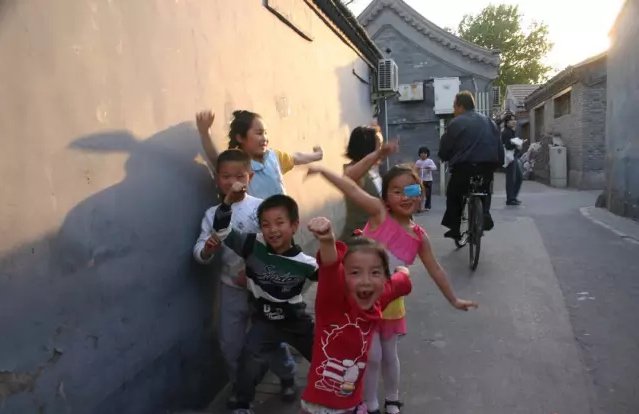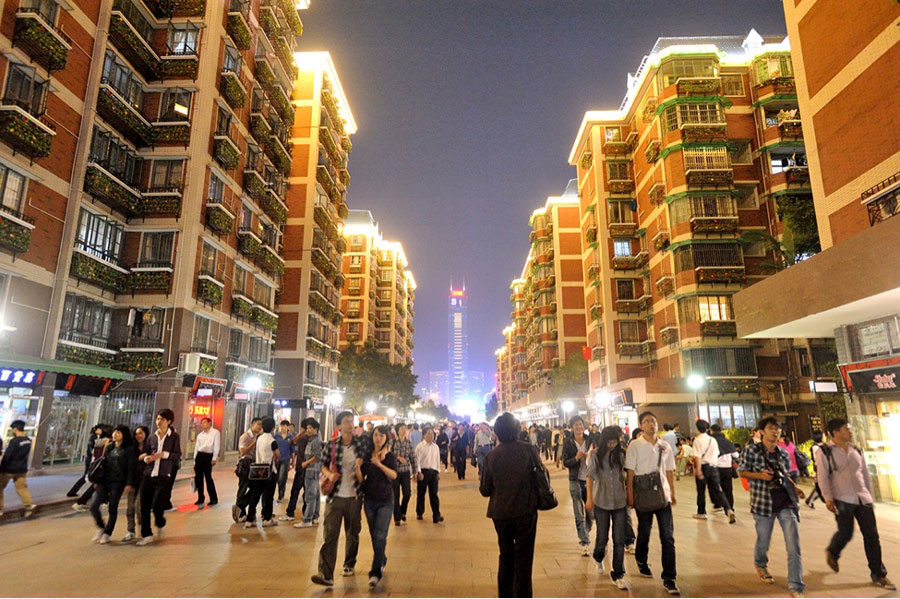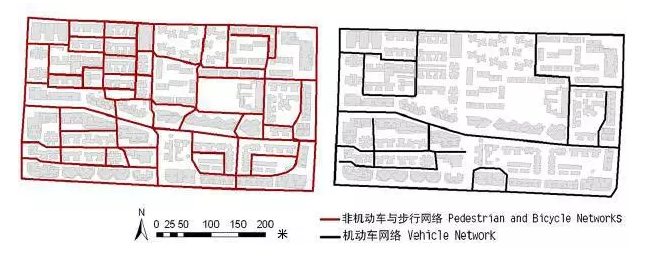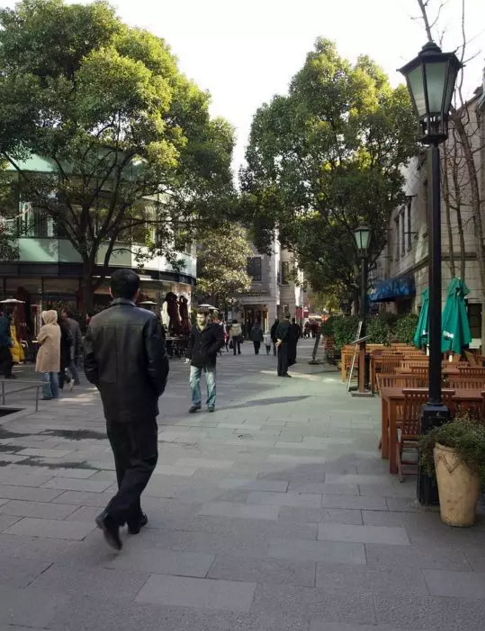 By Lili Pike 克里斯 布什
By Lili Pike 克里斯 布什
**This article was originally published in Chinese by The Paper on February 5, 2016. An English and Chinese version has also been posted on The Paper’s WeChat account.**
From massive superblocks to seemingly infinite series of ring roads, Chinese cities have increasingly been designed to serve cars. As Chinese people purchase more cars in line with this urban design, the trend is leaving its mark: congestion clogs streets and smog spews from ubiquitous cars, putting urbanites in an all too literal chokehold. In the midst of it all, Yeats’ words ring: “Turning and turning in the widening gyre/[…]/things fall apart; the center cannot hold.”
One of the things falling apart, in the wake of this gasoline gyre, is something far less conspicuous than car culture, yet critical to China’s future: walkability. Urbanization in China has occurred at a breakneck pace over the past few decades and it is only expected to continue, with 250 million urbanites to be added by 2030. As cities have expanded to absorb the influx of migrants, developers have built superblocks, half-a-kilometer square, that make walking difficult and unappealing, thereby pushing people towards driving. In a 2013 CCICED study in Beijing, Shanghai, and Shenzhen 82 percent of surveyed residents reported dissatisfaction with the walkability of their neighborhood. Without accessible walking routes and nearby amenities, residents opt for car travel—superblock residents drive four times as much as residents of traditionally laid-out neighborhoods.
Meanwhile, in the few remaining historic districts in Chinese cities, the pedestrian world is preserved. Streets are often too narrow for cars to pass so residents take to their bikes or, more simply, their feet to go about their lives. Free from honks and fumes, these neighborhoods contain continuous webs of life. Elderly residents play mahjong on corners, only interrupted by kids darting between doorways—the connected siheyuan serving as their playground. Local groceries and dumpling and chuanr stands are placed at every corner—making these neighborhoods nearly self-sufficient.

Figure 1. Kids at play in a Beijing hutong. Source: Lili Pike.
While this nostalgic nod to historic hutong life has been made before, the street life these traditional neighborhoods contain is increasingly being recognized as an important goal of new developments. Not only does the walkability of these neighborhoods create closer social networks, putting people at the center of urban planning also drives broader environmental, social, and economic benefits.
Despite the dominant trend of sprawling, car-dependent development, this type of thinking is gaining traction at high-levels. The country’s first national urbanization plan, released last year, emphasizes the importance of people-centered, pedestrian-friendly urban development. In addition, the 2012 “Guidance for Strengthening the Construction of Urban Non-Motorized Transportation System,” MOHURD, NDRC, and the Ministry of Finance calls for walking and cycling to account for at least 45 percent of journeys made by the public in cities with a population of over 10 million in 2015. While the hutong model will not be applicable given the sheer number of people that cities will need to accommodate, it can impart lessons to new development about what flourishing street life can look like and the importance of giving space to people and not cars.

Figure 2. Liuyun Xiaoqu by night: although mostly shuttered for the evening here, the first floor of all buildings house shops, making this a mixed use development. Source: CC Huang.
Enter Liuyun Xiaoqu (六运小区) —a modern neighborhood in Guangzhou. From a distance Liuyun Xiaoqu may seem like any other residential development in today’s China. Apartment buildings of the same hue and build extend row upon row. And yet, walking into the compound, a difference immediately confronts you: a small maze of plant boxes blocks the entrance allowing only pedestrians (and their bikes) in. Once past the maze, pedestrians meet another surprising feature: in Liuyun the first floor of the apartment buildings house a series of shops and restaurants, bucking the development trend of superblocks devoted entirely to either residential or commercial use. This “mixed-use” zoning further enhances the neighborhood’s walkability because residents do not have to venture by car to buy the goods that are literally at their doorsteps.
Not only do these simple steps taken to block off cars make Liuyun Xiaoqu a much more appealing space for pedestrians, this design also carries major environmental benefits. A recent study in China showed that a more walkable urban form could reduce GHG emissions in China from the transportation sector by 29 percent. This means that the proliferation of neighborhoods like Liuyun Xiaoqu, which inherently promote walking, could make a major difference in China’s contribution to global warming. As CO2 emissions from transportation are predicted to increase another 54 percent by 2020 from 2010 levels, these decisions about basic urban form for new developments will be critical to reducing urban emissions. From a public health perspective, a reduction in car usage would also reduce PM2.5 — which has already been shown to impose grave health risks with prolonged exposure.

Figure 3. This map comparing the density of pedestrian routes versus car routes in Liuyun XIaoqu shows why the neighborhood encourages walkability over car usage. Most places are simply more accessible by foot.
While Liuyun Xiaoqu is only one neighborhood, it provides an important example for how the walkability of historic hutongs can be carried forward into new sustainable development as the country continues to urbanize. As one of the few Chinese locations on the Institute for Transit and Development’s (ITDP) global ranking of Transit-Oriented Development (TOD), Liuyun is a critical example of how to bring walkability into the modern Chinese context.

Figure 4. Man Walking in Xintiandi. Source: Wikipedia.
765 miles northeast, a more recent development in Shanghai further amplifies Liuyun Xiaoqu’s lessons. Xintiandi (新天地) is a district in Shanghai that is devoted to pedestrians. Developed in the early 2000s, Xintiandi was designed to draw from the area’s historic roots, maintaining its traditional architecture and cobblestone streets while adding modern shops, restaurants, and nightclubs. Initially, doubts were expressed about this blend of tradition and modern commerce, but Xintiandi has been immensely successful since its 2006 launch. This success confirms the findings from Gehl Architect’s Public Space/Public Life survey in Chongqing that showed 150% more people were spending time in old, small streets than in the new, commercial public spaces, and 640% more people were spending time in traditional Chinese neighborhoods with active, open facades than in streets with closed building fronts. By bringing the vitality of those traditional neighborhoods into a new commercial space, Xintiandi capitalizes on these preferences. The project was so notable that it has become a verb; in developer-speak, “to Xintiandi” now means to create a walkable, human-scale development.
Beyond its commercial renown, Xintiandi also exemplifies the importance of urban form in promoting physical exercise, which leads to improved health outcomes. A study done in greater Shanghai shows that people whose commute involves physical activity have a 50 percent reduced risk of developing colon cancer. From a more macro health perspective, a recent study in Shanghai and Hangzhou showed that people living in more walkable neighborhoods have a lower Body-Mass-Index (BMI). This means that urban form has an impact on physical activity and weight.
While these developments are good examples of how walkability can be implemented in China, future urban developments must take advantage of the opportunity to think through urban form holistically from a pedestrian view point. Like Liuyun Xiaoqu and Xintiandi, car control and appealing public spaces are critical ingredients. However, walkable neighborhoods can only be fully achieved if everything a resident needs is accessible without a car, so mixed-use zoning, as well as good bike and walking paths and high quality public transit are also essential. For pedestrian life to flourish, all of these components must be combined. The Walkability Index created by the Natural Resources Defense Council (NRDC) is a good starting point for cities to understand where they can improve and how they compare in terms of safe and accessible pedestrian environments.
Although this will certainly require more detailed planning and better management, the benefits of feet taking to streets, rather than cars, are important for China’s environmental, economic, and social prosperity. Walkability can already be found within hutong streets, and in a few new developments across the country like Xintiandi—now as ten New York Cities’ worth of urban space is to be built in China by 2025, it is ever more critical to approach this growth step by step.
